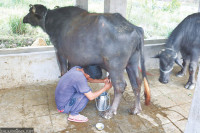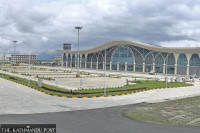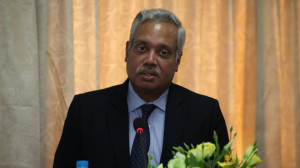National
Anti-graft body summons Ramdev, Balkrishna in Nepal land scam probe
Patanjali leaders refuse to appear, citing Nepali representative’s responsibility.
Matrika Dahal
Nepal’s anti-corruption body has summoned Indian yoga guru Ramdev and his associate Acharya Balkrishna for questioning over alleged misappropriation of land acquired under government exemptions for legal ownership ceiling. Both have refused to appear, citing local representative Shaligram Singh as solely responsible for dealings for land purchased in Banepa, Kavrepalanchok district.
According to the Commission for the Investigation of Abuse of Authority (CIAA), around Rs1.51 billion was funnelled into Patanjali Yogpeeth Nepal since 2015 via remittance channels, rather than through foreign direct investment or legal provisions under social welfare laws.
The CIAA said summons letters were sent to Patanjali’s Haridwar headquarters in February, with responses received in late April stating that Singh was authorised to act on behalf of the organisation in Nepal. Officials say the letters were part of a broader effort to include all key figures in the land dealings under investigation.
“As part of our effort to bring all those linked to the land case under investigation, a summons letter was sent to Ramdev and Balkrishna, but they responded stating that Patanjali has been operating in Nepal through a power of attorney and that Singh alone is responsible,” said the CIAA official.
Patanjali Yogpeeth Nepal, a non-profit registered in January 2008, has Ramdev, Balkrishna, Shaligram, Rajendra Singh, and Umesh Sarraf as its proprietors. The CIAA said Shaligram has been central to Patanjali’s operations in Nepal since its inception and was the main actor in land acquisitions made under ceiling exemptions granted by the government.
On February 1, 2010, the Cabinet approved the purchase of 815 ropani (1 ropani equals 0.0509 hectares) of land in Banepa under the ceiling exemption for purposes including yoga centres, Ayurvedic institutes, and the herbal industry. The same Cabinet meeting also approved the purchase of land under ceiling exemption—75 bighas (1 bigha equals 0.677 hectares) in Dang, 300 ropanis in Lamjung, 250 ropanis in Syangja, 15 bighas in Chitwan, 25 bighas in Dhanusha, 150 ropanis in the Kathmandu Valley, and 40 bighas in the Bara–Parsa area—within five years. However, no investigation has been carried out into the transactions involving the other plots approved under the exemption.
After receiving Cabinet approval, Patanjali’s Nepal chief Shaligram, purchased 593 ropanis, 5 annas, and 3 paisas of land in the areas of Nasikasthan, Sanga, Mahendrajyoti, and Chalal Ganeshsthan in Banepa. The decision-making process to grant approval for purchasing land under the ceiling exemption involved then Prime Minister Madhav Kumar Nepal, then Land Reform Minister Dambar Shrestha, then Chief Secretary Madhav Ghimire, then Secretary Chhabiraj Pant, along with other high-ranking officials and employees.
Within a month of receiving approval to purchase land under the ceiling exemption, on February 19, 2010, Patanjali’s Nepal chief Shaligram submitted an application to the then Land Reform Minister Shrestha seeking permission to sell the land acquired under the exemption.
On March 16 of the same year, citing “as per Prime Minister Nepal’s instruction,” Minister Shrestha took the proposal to the Cabinet to allow Patanjali to sell the land obtained through the ceiling exemption.
Three days later, the Cabinet decided to approve the sale of the exempted land. However, on March 30, 2010, then Director General of the Land Reform Department Keshar Bahadur Baniya, sent a letter to the ministry stating that the Cabinet’s decision was illegal and could not be implemented.
On April 8, 2010, the Cabinet decided to seek clarification from Director General Baniya, accusing him of challenging the approval given for the sale of land exempted from the land ceiling. The next day, to support the planned sale of the exempted land, Baniya was allegedly removed from his position as Director General, and Joint Secretary Jit Bahadur Thapa of the ministry was appointed in his place.
On the very same day he assumed the role, Thapa sent a letter to the Kavre Land Revenue Office granting approval for the sale of the land exempted from the land ceiling.
On June 25, 2010, Patanjali sold 353 ropani and 15 aana of land to Kasthamandap Business Homes Pvt Ltd. The investigation has also revealed financial irregularities in the land transaction.
When Patanjali sold the land in Banepa, the recorded price was Rs42.25 million. Government records show that Patanjali later bought 104 ropani, 1 aana, 2 paisa, and 1 dam of land in Dhulikhel for Rs10.75 million. However, an official from the CIAA alleges that the actual transactions exceeded Rs400 million, with the declared amounts deliberately reduced to evade taxes.
The official said, “A sale price of around Rs100,000 per ropani is not credible.”
The CIAA has been investigating for a year the alleged irregularities in land bought under government exemption for a specific purpose.
The investigation has recorded statements from key decision-makers involved in the transaction process, including former Prime Minister Nepal, then-Secretary Pant, Patanjali Nepal’s Singh, as well as officials from the Land Revenue Office, the Department of Land Management, and relevant ministry staff.
The then-Chief Secretary Ghimire, who was involved in the decision-making process, went missing after a car he was travelling in plunged into the Trishuli River on September 25, 2016. The former Minister for Land Reform, Shrestha, passed away on October 7, 2024.




 6.12°C Kathmandu
6.12°C Kathmandu















